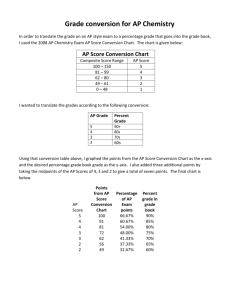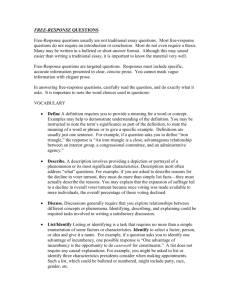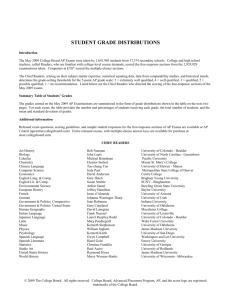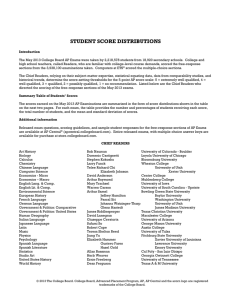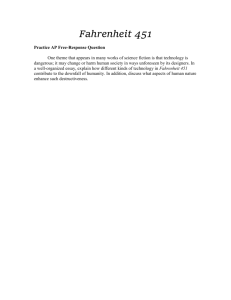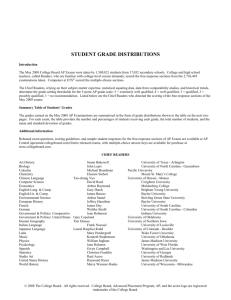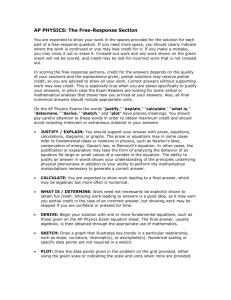The AP Macroeconomics Exam
advertisement
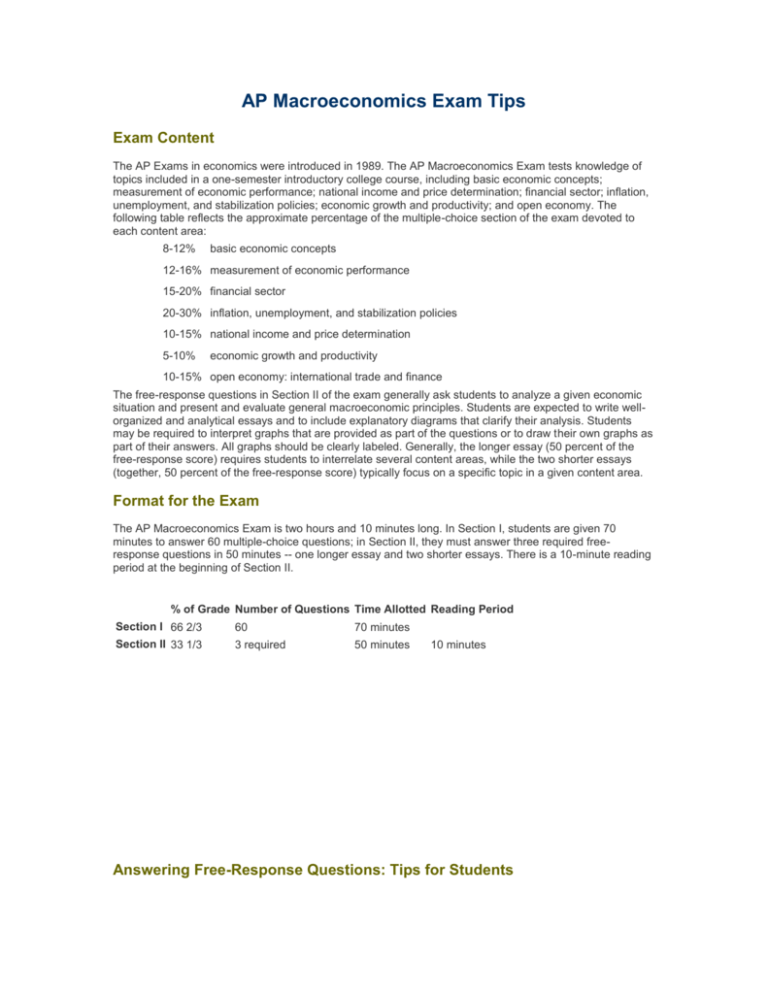
AP Macroeconomics Exam Tips Exam Content The AP Exams in economics were introduced in 1989. The AP Macroeconomics Exam tests knowledge of topics included in a one-semester introductory college course, including basic economic concepts; measurement of economic performance; national income and price determination; financial sector; inflation, unemployment, and stabilization policies; economic growth and productivity; and open economy. The following table reflects the approximate percentage of the multiple-choice section of the exam devoted to each content area: 8-12% basic economic concepts 12-16% measurement of economic performance 15-20% financial sector 20-30% inflation, unemployment, and stabilization policies 10-15% national income and price determination 5-10% economic growth and productivity 10-15% open economy: international trade and finance The free-response questions in Section II of the exam generally ask students to analyze a given economic situation and present and evaluate general macroeconomic principles. Students are expected to write wellorganized and analytical essays and to include explanatory diagrams that clarify their analysis. Students may be required to interpret graphs that are provided as part of the questions or to draw their own graphs as part of their answers. All graphs should be clearly labeled. Generally, the longer essay (50 percent of the free-response score) requires students to interrelate several content areas, while the two shorter essays (together, 50 percent of the free-response score) typically focus on a specific topic in a given content area. Format for the Exam The AP Macroeconomics Exam is two hours and 10 minutes long. In Section I, students are given 70 minutes to answer 60 multiple-choice questions; in Section II, they must answer three required freeresponse questions in 50 minutes -- one longer essay and two shorter essays. There is a 10-minute reading period at the beginning of Section II. % of Grade Number of Questions Time Allotted Reading Period Section I 66 2/3 60 70 minutes Section II 33 1/3 3 required 50 minutes 10 minutes Answering Free-Response Questions: Tips for Students Students should keep the following suggestions in mind when answering questions in Section II of the AP Exam: Do not restate the question. Use correct terminology. For example, money and income are often confused, or aggregate demand will be labeled "D," and discussed as though it were the market demand for a particular product. Learn and use the correct language of macroeconomics. If the question requires you to draw a graph, you must do so to receive full credit. Even if a graph is not required, it may be to your advantage to draw one anyway. Often students use the wrong economic terminology, but clearly indicate they understand what is happening by using a correct graph. On the other hand, graphs are not magical tools that ensure high scores; they are useful tools in making arguments, but they don't stand alone. It is important that the story they tell is explained. Label graphs clearly, correctly, and fully. Points are lost when readers can't figure out what you're trying to explain with a graph that isn't labeled correctly. Take particular care to label each axis and to identify each curve on the graph. Changes in curves should be indicated clearly with arrows or with some clear sequencing, such as showing a change in aggregate supply with AS and AS' or AS1 and AS2. Use the same outline numbers or letters from the question in your answer, and answer them in the same order. This helps the faculty consultant know where to look for specific answers to specific parts of the question. It also helps you remember to include all parts of the question in your answer. Many free-response questions are divided into parts such as (a), (b), (c), and (d), with each part calling for a different response. Credit for each of these parts is awarded independently, so you should attempt to answer them all. If the answer to a later part of a question depends on the answer to an earlier part, you may still be able to receive full credit for the later part, even if the earlier answer is wrong. For example, you may receive no credit for your answer to part (a), but still receive full credit for parts (b), (c), and (d), as long as these answers are logically consistent with the answer to part (a). The different parts of the free-response questions are presented in a logical manner; answer the parts in the order that they are asked. Emphasize the line of reasoning that generated your answer. If you make an assertion such as "the price increased," explain why the price increased. Use the 10-minute reading period to plan your answer. Then you will have 50 minutes to answer all three questions in the free-response segment. Spend approximately half the time (25 minutes) on the long question and divide the remaining time between the other two questions. Remember that you may answer the questions in any order. For instance, you may wish to answer the question you feel most confident about first. However, be sure to indicate clearly in your answer booklet which question you are answering. Don't bring a calculator to the exam. Calculators are not allowed. Problems appearing in the exams usually require only basic math skills, so practice solving such problems without the use of calculators. Improving Scores on Free Response Question Carefully read the question from start to finish Answer the question in order asked Be succinct. No fluff. Do not restate the question Use graphs (label everything correctly) Do not make assertions without explanations Know and tell the story of policy transmission mechanisms Understand the effects of fiscal policy on interest rates Know the difference between fluctuations in GDP and long term economic growth Understand the relationship of fiscal policy and monetary policy to international economics (net export effect) Understand the difference between real and nominal numbers Areas of Continuing Error Graphing and labeling Assertions without explanations Long run answers when short run answers are expected Confusion between money and income Failure to link a change in investment with investment with anything other than a change in AD Misinterpreting how a change in domestic interest rates affect a nation’s currency Understanding the difference between monetary and fiscal policies Failure to understand the difference between nominal and real rates Problems with international trade questions Incomplete linkages Assuming that an increase in GHDP is always evidence of economic growth Spending too much time on differences in Monetarist and Keynesian thought
